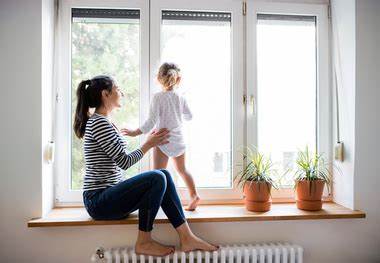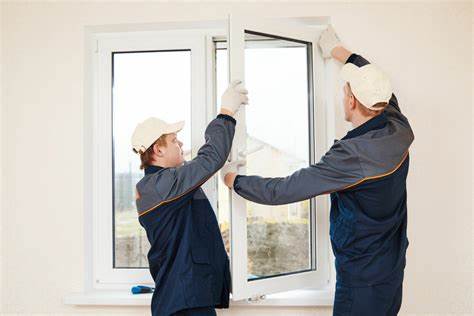Casement windows are a type of window that is attached to its frame by one or more hinges at the side. They are often used in various types of buildings due to their functional and aesthetic qualities. The name “casement” comes from the Latin word “casamentum,” which means a building or part of a building. Casement windows open outward, either to the left or right, unlike sliding windows which open by sliding along a track.
Types of Casement Windows
Casement windows come in various styles to suit different needs and preferences. They can be side-hinged, top-hinged (awning), or bottom-hinged, each offering unique benefits. Understanding the types helps you choose the best windows for your home.

Traditional Casement Windows
Traditional casement windows are attached to their frame by one or more hinges at the side. They crank open outward, allowing for maximum ventilation and fresh air. These windows are a common choice for traditional homes, providing a classic look. Many homeowners choose casement windows for their excellent energy efficiency and ease of use. Traditional casement windows are low maintenance and extremely durable, making them a cost-effective option.
Awning Casement Windows
Awning casement windows are hinged at the top and open outward from the bottom. These windows are often placed above doors or other windows to provide extra ventilation. Awning windows are ideal for areas where you want to maintain airflow even during light rain. Many kitchens and bathrooms use awning windows for their practicality and ease of cleaning. These windows are also energy efficient, helping to reduce heating and cooling costs.
Sliding Casement Windows
Sliding casement windows open by moving horizontally along a track. They are a great option for rooms where space is limited, such as over a kitchen sink or in a living room. Sliding windows are easy to operate and require minimal maintenance. These windows offer good air flow and are often used in modern homes. Replacement windows of the sliding type are popular for their simplicity and sleek design.
Double Hung Casement Windows
Double hung casement windows have two sashes that move up and down. This design allows for versatile ventilation, as you can open either the top or bottom sash. These windows are a staple in many traditional homes and provide a classic appearance. Double hung windows are easy to clean since both sashes can tilt inward. They are also known for their energy efficiency and ability to enhance air flow.
Picture Casement Windows
Picture casement windows are large, fixed windows that do not open. They are designed to provide unobstructed views and allow maximum natural light into a room. These windows are often used in living rooms to frame a beautiful outdoor scene. Picture windows are energy efficient because they are sealed and do not have moving parts. They are a perfect window type for areas where ventilation is not a priority but views and light are important.
Bay Casement Windows
Bay casement windows are a combination of three or more windows that extend outward from a room. This design creates a small nook or shelf inside, which can be used for seating or decoration. Bay windows provide panoramic views and add architectural interest to a home. These windows also allow for excellent air flow when the side windows are operational. Bay windows are often chosen for living rooms and bedrooms to enhance space and light.
Crank Casement Windows
Crank casement windows, also known as crank-open windows, are operated by a hand crank. This mechanism allows the window to open outward, similar to traditional casement windows. Crank windows are easy to use and provide excellent energy efficiency. They are often found in kitchens and bathrooms where ease of access and ventilation are important. Crank windows are durable and require little maintenance, making them a popular choice for replacement windows.
Benefits of Casement Windows
Casement windows offer numerous advantages for homeowners. Their design allows for maximum ventilation and easy operation. These windows are also low maintenance, providing long-term cost savings and convenience.

Style
Casement windows offer a sleek, modern look that enhances any home. These windows suit various architectural styles, including contemporary and traditional homes. The clean lines and unobstructed views make them a beautiful addition to your house. Casement windows complement both interior and exterior designs, adding aesthetic value. They are the best option for those looking to upgrade their home’s style.
Ventilation
Casement windows are hinged at the side and open outward, allowing maximum ventilation. They catch side breezes, directing fresh air into your home. This feature makes them ideal for kitchens and bathrooms, where ventilation is crucial. Fully opened casement windows provide excellent airflow compared to other window types. The design helps to keep the interior fresh and comfortable.
Energy Efficiency
Casement windows are highly energy-efficient due to their tight seal. The frames press firmly against the sash when closed, reducing air leakage. This feature helps in maintaining a consistent indoor temperature, which can lower heating and cooling costs. These windows often come with energy-efficient glass and materials. This makes them a cost-effective option for homeowners looking to save on energy bills.
Security
Casement windows offer superior security features compared to other types of windows. The hook-shaped locks embedded within the frame make them very difficult to break into. The design, which opens outward, also deters potential intruders. Casement windows often come with additional security options, such as reinforced frames and impact-resistant glass. These features provide peace of mind for homeowners concerned about security.
Versatility
Casement windows come in various styles and materials, making them versatile for any home. You can choose from wood, timber, or other durable materials to match your home’s decor. These windows are suitable for different locations in the house, including living rooms, bathrooms, and kitchens. The flexibility in design and installation options makes casement windows a preferred choice for many. They are also compatible with patio doors and can be used in conjunction with screens for added functionality.
Materials Used for Casement Windows
Casement windows come in various materials to suit different needs and preferences. The most common materials include wood, vinyl, aluminum, and fiberglass. Each material offers unique advantages in terms of durability, maintenance, and aesthetics. Choosing the right material depends on your budget, climate, and the style of your home. Understanding the properties of each can help you make an informed decision.

Wood
Wood is a common material for casement windows. The advantages of wood include its natural look and good insulation. Wood is often used in traditional homes for its classic appearance. You can easily install wood casement windows in kitchens or bathrooms. However, wood requires regular maintenance to prevent rot and warping.
Vinyl
Vinyl casement windows are popular for their low maintenance. They are resistant to weather and do not need painting. These windows are a cost-effective option for homeowners. Vinyl is also a good choice for areas like the kitchen sink or bathroom. The material can be less attractive than wood but offers practical benefits.
Aluminum
Aluminum is a durable material used for casement windows. It is lightweight and resistant to rust. Aluminum windows can withstand strong winds, making them ideal for high-rise buildings. They are often installed in modern homes due to their sleek look. However, aluminum provides less insulation compared to wood or vinyl.
Fiberglass
Fiberglass casement windows are known for their strength and durability. They offer advantages like low maintenance and good insulation. Fiberglass is a suitable material for both traditional homes and modern designs. These windows can be installed in places exposed to weather, like near a kitchen sink or bathroom. The cost of fiberglass windows can be higher than vinyl or aluminum.
Composite
Composite windows combine materials like wood and vinyl. They offer the benefits of both, such as good insulation and low maintenance. Composite casement windows are versatile and can fit various home styles. These windows are often installed in areas that need durable and attractive windows. They can be more expensive but offer long-term benefits.
Installation Considerations
Installing casement windows requires careful planning. You need to consider various factors to ensure they fit well in your space. Understanding the benefits and limitations will help you make informed decisions. Proper installation enhances both functionality and aesthetics. This guide will cover essential aspects to consider for a successful installation.

Space Requirements
Check the available space before you install casement windows. Ensure that the windows can open fully without obstruction. Consider the hinge placement for optimal function. Plan for enough room to clean the windows easily. Avoid placing them in areas with high wind exposure.
Compatibility with Existing Architecture
Match the window style with your home’s architecture. Casement windows suit traditional homes well. They blend seamlessly with both modern and classic designs. Consider sash windows for a cohesive look. Ensure the windows do not clash with existing aesthetics.
Room-Specific Considerations
Casement windows work well in bathrooms. Their design offers good ventilation and privacy. They are also ideal for kitchens, especially above the kitchen sink. Awning windows can complement them in these spaces. Choose the best windows for each specific room.
Functional Benefits
Casement windows have many advantages. They offer excellent ventilation and are easy to operate. These windows are low maintenance, saving you time and effort. The hinged side allows for easy cleaning from inside the house. They also provide a clear, unobstructed view, similar to picture windows.
Cost Considerations
Consider the cost before you decide to install casement windows. They may be more expensive than other types, like double-hung windows. Factor in long-term savings due to their low maintenance. Consider the cost of professional installation if needed. Weigh the benefits against the initial investment to make the best decision.
Hinge Placement
Decide on the hinge placement carefully. Casement windows can be hinged on one side or both. Hinges on the side provide better ventilation control. Ensure the hinges allow the windows to open fully. Proper hinge placement also impacts the ease of cleaning and maintenance.
Wind Resistance
Evaluate the wind resistance of casement windows. These windows are ideal for areas with strong winds. Their design helps them seal tightly when closed. This feature reduces drafts and improves energy efficiency. Make sure to install them securely to withstand high wind conditions.
Installation Around Existing Features
Plan the installation around existing features like walls and fixtures. Casement windows work well near kitchen sinks due to their easy opening mechanism. Ensure they do not interfere with other elements like cabinets. Align the installation with the overall room design for a cohesive look.
Aesthetic Appeal
Consider the aesthetic appeal of casement windows. They add a modern touch to traditional homes. Their sleek design enhances the overall look of your house. Pair them with picture windows for a panoramic view. Their clean lines suit both contemporary and classic architectural styles.
Maintenance Requirements
Think about the maintenance requirements before installation. Casement windows are low maintenance compared to sash windows. They are easier to clean due to their hinged side. Regular lubrication of hinges ensures smooth operation. Periodic checks and cleaning will keep them in good condition.
Closing Thoughts
Casement windows offer a perfect blend of functionality, style, and efficiency for homeowners. From their superior ventilation and energy efficiency to their enhanced security features and versatile design options, casement windows prove to be an excellent choice for various architectural styles and practical needs. Whether you’re renovating an older home or building a new one, the diverse range of materials and styles available ensures that you can find casement windows that not only meet your functional requirements but also enhance the aesthetic appeal of your living spaces.
Get Started Today
Ready to transform your home with the perfect casement windows? Take the next step in your home improvement journey. Contact us to get started and claim a FREE Estimate!
